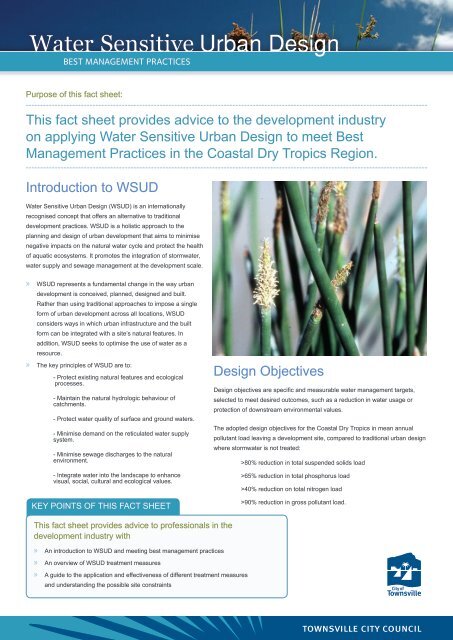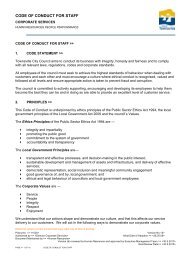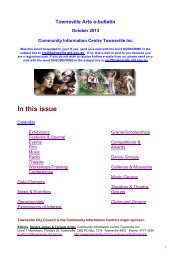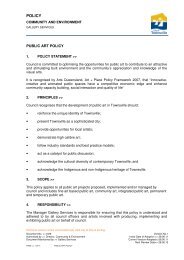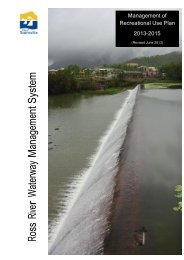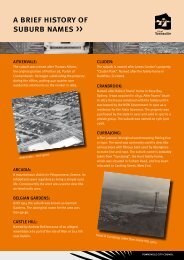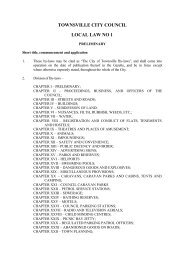Water Sensitive Urban Design - Townsville City Council
Water Sensitive Urban Design - Townsville City Council
Water Sensitive Urban Design - Townsville City Council
You also want an ePaper? Increase the reach of your titles
YUMPU automatically turns print PDFs into web optimized ePapers that Google loves.
<strong>Water</strong> <strong>Sensitive</strong> <strong>Urban</strong> <strong>Design</strong><br />
BEST MANAGEMENT PRACTICES<br />
Purpose of this fact sheet:<br />
This fact sheet provides advice to the development industry<br />
on applying <strong>Water</strong> <strong>Sensitive</strong> <strong>Urban</strong> <strong>Design</strong> to meet Best<br />
Management Practices in the Coastal Dry Tropics Region.<br />
Introduction to WSUD<br />
<strong>Water</strong> <strong>Sensitive</strong> <strong>Urban</strong> <strong>Design</strong> (WSUD) is an internationally<br />
recognised concept that offers an alternative to traditional<br />
development practices. WSUD is a holistic approach to the<br />
planning and design of urban development that aims to minimise<br />
negative impacts on the natural water cycle and protect the health<br />
of aquatic ecosystems. It promotes the integration of stormwater,<br />
water supply and sewage management at the development scale.<br />
»»<br />
WSUD represents a fundamental change in the way urban<br />
development is conceived, planned, designed and built.<br />
Rather than using traditional approaches to impose a single<br />
form of urban development across all locations, WSUD<br />
considers ways in which urban infrastructure and the built<br />
form can be integrated with a site’s natural features. In<br />
addition, WSUD seeks to optimise the use of water as a<br />
resource.<br />
»»<br />
The key principles of WSUD are to:<br />
- Protect existing natural features and ecological<br />
processes.<br />
- Maintain the natural hydrologic behaviour of<br />
catchments.<br />
- Protect water quality of surface and ground waters.<br />
- Minimise demand on the reticulated water supply<br />
system.<br />
- Minimise sewage discharges to the natural<br />
environment.<br />
- Integrate water into the landscape to enhance<br />
visual, social, cultural and ecological values.<br />
KEY POINTS OF THIS FACT SHEET<br />
<strong>Design</strong> Objectives<br />
<strong>Design</strong> objectives are specific and measurable water management targets,<br />
selected to meet desired outcomes, such as a reduction in water usage or<br />
protection of downstream environmental values.<br />
The adopted design objectives for the Coastal Dry Tropics in mean annual<br />
pollutant load leaving a development site, compared to traditional urban design<br />
where stormwater is not treated:<br />
>80% reduction in total suspended solids load<br />
>65% reduction in total phosphorus load<br />
>40% reduction on total nitrogen load<br />
>90% reduction in gross pollutant load.<br />
This fact sheet provides advice to professionals in the<br />
development industry with<br />
»»<br />
An introduction to WSUD and meeting best management practices<br />
»»<br />
An overview of WSUD treatment measures<br />
»<br />
» A guide to the application and effectiveness of different treatment measures<br />
and understanding the possible site constraints
WSUD Treatment Measures<br />
There are a range of WSUD treatment measures available. The selection of the device will vary from site to site, so it<br />
is important that the most appropriate treatment measures are chosen based on assessments of site characteristics.<br />
Different treatment measures also provide different levels of treatment. In most cases a combination of devices acting<br />
as a treatment train provides the best overall stormwater treatment.<br />
Primary Treatment Measures<br />
These treatment devices usually target<br />
litter and other gross pollutants and course<br />
sediment.<br />
Litter (trash) rack and Gross pollutant<br />
traps:These litter collection devices are<br />
intended to retain gross organic and<br />
anthropogenic litter that is washed from urban<br />
surfaces. They rely predominantly on physical<br />
screening rather than flow retardation to<br />
remove litter<br />
Oil collector/trap: There are currently a number<br />
of oil and grease separators being used in the<br />
stormwater industry, with varying success. The<br />
separation of oil and grease in such systems<br />
rely on near-quiescent flow conditions and are<br />
most appropriate when used in treating runoff<br />
from clearly isolated oil and grease source<br />
areas (i.e. limited stormwater peak flows).<br />
Sediment trap: Sedimentation basins are<br />
stormwater detention systems that promote<br />
settling of sediments through the reduction of<br />
flow velocities and temporary detention. They<br />
can take various forms and can be used as<br />
permanent systems integrated into an urban<br />
design, or temporary measures to control<br />
sediment discharge during construction.<br />
Secondary Treatment Measures<br />
These devices usually target sediments, with<br />
partial removal of heavy metals and bacteria.<br />
Buffer strips: Buffer strips (or buffers) are areas<br />
of vegetation through which runoff passes while<br />
travelling to a discharge point. They reduce<br />
sediment loads by passing a shallow depth<br />
of flow through vegetation and rely upon well<br />
distributed sheet flow. With their requirement<br />
for uniformly distributed flow, buffer strips are<br />
suited to treatment of road runoff in situations<br />
where road runoff is discharged via flush kerbs<br />
or through regular kerb ‘cut-outs’.<br />
Swales: Vegetated swales provide a means<br />
of disconnecting impervious areas from<br />
downstream waterways, assisting in protecting<br />
waterways from damage by frequent storm<br />
events, by reducing flow velocity compared<br />
with piped systems. They provide removal<br />
of coarse and medium sediments and are<br />
commonly combined with buffer strips and<br />
bioretention systems to provide further<br />
treatment.<br />
Sand filters: Sand filters operate in a similar<br />
manner to bioretention systems, with the<br />
exception that stormwater passes through<br />
a filter media (typically sand) that has no<br />
vegetation growing on the surface, reducing<br />
their treatment performance comparatively. The<br />
absence of vegetation is due to low moisture<br />
content in the sandy soils and low light due to<br />
systems often being installed underground.<br />
Sand filters should only be considered where<br />
site conditions, such as space or drainage<br />
grades, limit the use of bioretention systems.<br />
Infiltration systems: These systems do not<br />
treat stormwater, but capture runoff and<br />
encourage infiltration into surrounding in-situ<br />
soils and underlying groundwater. This has<br />
the benefit of reducing stormwater runoff peak<br />
flows and volumes, reducing downstream<br />
flooding, managing the hydrologic regime<br />
entering downstream aquatic ecosystems and<br />
improving groundwater recharge.<br />
Tertiary Treatment Measures<br />
These aim to remove nutrients, bacteria, fine<br />
sediments and heavy metals.<br />
Bioretention systems: Bioretention systems<br />
operate by filtering stormwater runoff through<br />
densely planted surface vegetation and then<br />
percolating runoff through a prescribed filter<br />
media. During percolation, pollutants are<br />
retained through fine filtration, adsorption and<br />
some biological uptake.<br />
Constructed Wetlands: Constructed wetland<br />
systems are densely vegetated water bodies<br />
that use enhanced sedimentation, fine filtration<br />
and biological uptake processes to remove<br />
pollutants from stormwater.<br />
Source controls<br />
These devices aim to minimise the quantity<br />
of stormwater runoff generated, therefore<br />
minimising the size requirements of additional<br />
WSUD treatment measures in a treatment<br />
train.<br />
»»<br />
Rainwater tanks<br />
»<br />
» Porous pavement<br />
<strong>Water</strong> sensitive urban design in the coastal dry tropics
Selection of Appropriate WSUD Treatment Devices<br />
Not all of the stormwater management measures presented in this factsheet are suitable for any given site.<br />
Appropriate measures should be selected by matching device characteristics to target pollutants and the<br />
physical constraints of the site.<br />
Table 1: Site Conditions and Benefits of WSUD Treatments (adapted from the <strong>City</strong> of Melbourne’s <strong>Water</strong><br />
<strong>Sensitive</strong> <strong>Urban</strong> <strong>Design</strong> Guidelines)<br />
TREATMENT MEASURE<br />
POTENTIAL<br />
BENEFITS<br />
SUITABLE SITE<br />
CONDITIONS<br />
UNSUITABLE<br />
CONDITIONS<br />
Gross Pollutant Trap<br />
Reduces litter and debris. Can<br />
reduce sediment. Pretreatment<br />
for other measures.<br />
Conventional drainage systems<br />
Sites larger than 100 ha.<br />
Natural channels<br />
Oil Collector/Trap Separate oil and grease Areas with clearly isolated oil<br />
and grease source areas (limited<br />
stormwater peak flows)<br />
Areas with high<br />
stormwarter peak flows<br />
Sediment Trap<br />
Course sediment capture.<br />
Temporary installation.<br />
Pretreatment for other<br />
measures.<br />
Need available land area.<br />
Proximity to airports<br />
Buffer Strips<br />
Pretreatment of run-off for<br />
sediment removal. Streetscape<br />
amenity.<br />
Flat terrain<br />
Steep terrain<br />
Swales<br />
Medium and fine particulate<br />
removal. Streetscape amenity.<br />
Passive irrigation.<br />
Mild slopes (< four per cent)<br />
Steep slopes<br />
Sand Filters Particulate removal Consider if site conditions limit<br />
bioretention systems<br />
Where other technology<br />
more appropriate<br />
Infiltration Systems<br />
Reduce peak flows and<br />
volumes and encourage<br />
infiltration<br />
Soils with high hydraulic<br />
conductivity<br />
Soils with very low<br />
hydraulic conductivity<br />
Bioretention Systems<br />
Fine and soluble pollutants<br />
removal. Streetscape amenity.<br />
Frequent flood retardation.<br />
Flat terrain<br />
Steep terrain. High<br />
groundwater table.<br />
Constructed Wetlands<br />
Community asset. Medium<br />
to fine particulate and some<br />
soluble pollutant removal.<br />
Flood retardation. Storage for<br />
reuse. Wildlife habitat.<br />
Flat terrain<br />
Steep terrain. High<br />
groundwater table. Acid<br />
sulphate soils<br />
Rainwater Tanks<br />
Storage for reuse. Sediment<br />
removal in tank. Frequent flood<br />
retardation.<br />
Proximity to roof Suitable site for<br />
gravity feed. Incorporate to urban<br />
design<br />
Non-roof run-off treatment<br />
Porous Pavement<br />
Provide flow attentuation and<br />
remove sediments and attached<br />
pollutants<br />
Best suited to catchments with<br />
flat terrain, low sediment loads<br />
and light vehicle weight<br />
High traffic volumes or<br />
weights, steep terrain,<br />
high sediments loads, high<br />
water table.
Selection of Appropriate WSUD Treatment Devices<br />
The following screening tools are available to assist in the selection of appropriate WSUD treatment devices<br />
based on the site and pollutant characteristics (from WSUD Technical <strong>Design</strong> Guidelines for the Coastal Dry<br />
Tropics, <strong>Townsville</strong> <strong>City</strong> <strong>Council</strong>).<br />
From the <strong>City</strong> of Melbourne’s <strong>Water</strong> <strong>Sensitive</strong> <strong>Urban</strong> <strong>Design</strong> Guidelines<br />
Table 1.2 Scale of WSUD Application in <strong>Urban</strong> Catchments<br />
WSUD Measure Allotment Scale Street Scale Precinct or<br />
Regional Scale<br />
Swales and buffer strips<br />
Bioretention Swales <br />
Sedimentation basins<br />
Bioretention basins <br />
Constructed wetlands <br />
Infiltration measures <br />
Sand filters <br />
Aquifer storage and recovery<br />
<br />
<br />
<br />
<strong>Water</strong> sensitive urban design in the coastal dry tropics
Selection of Appropriate WSUD Treatment Devices<br />
Device Screening Tools (continued)


